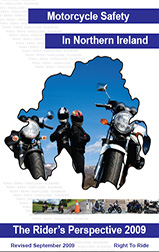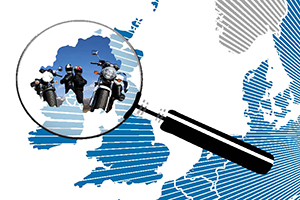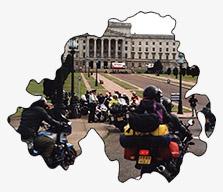Motorcycle Safety In Northern Ireland – The Rider’s Perspective – Revised September 2009
1st July 2009
 Right To Ride has published “Motorcycling in Northern Ireland – the Rider’s Perspective”, a document offering the views of motorcyclists as a point of reference for a Motorcycling Strategy in Northern Ireland.
Right To Ride has published “Motorcycling in Northern Ireland – the Rider’s Perspective”, a document offering the views of motorcyclists as a point of reference for a Motorcycling Strategy in Northern Ireland.
At the start of April 2009 we circulated a consultation document to Agencies, Government Departments, Politicians, Interested Parties and Individuals, which covered all the relevant issues about motorcycle safety.
At the end of the consultation, no input from any party in Northern Ireland was received. No comments, no suggestions for improvement, nor any additional information that could have been included.
However Right To Ride has met recently with officials from the Northern Ireland Department for Regional Development and Department of the Environment to discuss motorcycling in Northern Ireland. The highly focused meetings considered motorcycle safety strategies aimed at improving motorcycle road usage in general and at reducing road casualties.
Motorcycling has been included in-depth in the publication of a consultation on Road Safety Strategy in Northern Ireland.
Motorcycling is an integral part of Northern Ireland Transport.
The Department of the Environment (DOE) has published the Northern Ireland Road Safety Strategy (NIRSS) to promote an integrated approach to the planning, co-ordination and delivery of the Government’s road safety activities over the next decade.
It has identified the vulnerability of motorcyclists stating that motorcyclists should be encouraged to ride safely and “around 65% of collisions involving motorcyclists are caused primarily by other road users”.
The actions to reduce motorcycle casualties in the NIRSS cover some of the solutions, but what is evident is that there is no coherent motorcycle strategy in Northern Ireland.
The Department for Transport (DfT) in Great Britain produced a Motorcycling Strategy for England (published 2005). In 2007, the Motorcycling Community of Scotland produced a document endorsed by the Scottish Executive called “Motorcycling in Scotland, Guidance for Road Authorities in Scotland”.
England and Scotland have developed specific motorcycle strategies with the participation of all stakeholders. These examples have demonstrated the power of working together to improve conditions for motorcyclists.
In 2009 the Road Safety Authority (RSA) in Ireland launched a consultation which sought to obtain the input and views of a broad range of stake holders on the enhancement of motorcycle safety on Irish roads, through the development of a fully integrated Motorcycle Safety Action Plan.
Motorcycle Safety in Northern Ireland – The Rider’s Perspective
 The document aims to provide legislators, decision makers and motorcyclists with a document that collates the expertise of motorcyclists, based on years of experience, consultation and lobbying.
The document aims to provide legislators, decision makers and motorcyclists with a document that collates the expertise of motorcyclists, based on years of experience, consultation and lobbying.
It also aims to be a starting point for discussion and debate to develop a strategy for motorcycle safety in Northern Ireland by encompassing all stakeholders including the motorcycle community, individual riders, clubs, groups and associations.
The issues within this document are linked to the priorities for motorcycle safety identified during the International Transport Forum/OECD workshop on Motorcycling, held in Lillehammer, Norway in June 2008.
The twentieth priority summarized the importance of collaboration amongst all stakeholders: ‘working together to achieve common objectives’.
To download “Motorcycling in Northern Ireland – the Rider’s Perspective” Click Here 2.9mb
Download the Executive summary Click Here pdf 405kb
Trevor Baird
What about us – over 31,000 motorcycles registered?
 In Northern Ireland there are very little or next to zero activities for motorcycle safety. In April 2009 the Department of the Environment (DOE) launched its new road safety campaign focusing on biker vulnerability: the “Underneath” television advert ran from 14 May to 14 June 2009.
In Northern Ireland there are very little or next to zero activities for motorcycle safety. In April 2009 the Department of the Environment (DOE) launched its new road safety campaign focusing on biker vulnerability: the “Underneath” television advert ran from 14 May to 14 June 2009.
Although it seems to have hit the right spot in the analysis of the issues, it is a stand-alone road safety campaign that may wilt and fail to have any long lasting positive effect for motorcycle safety. There is not one mention of this motorcycle campaign (unlike other road safety campaigns featured and highlighted) on the DOE’s road safety website by the Road Safety Division.
The Road Safety Council of Northern Ireland (RSC) – which now seems to be defunct – is a voluntary organisation which is mainly funded through a grant from the Department of the Environment. The role of the RSC is to enhance the work of the Department by promoting voluntary road safety activities through events and competitions, organised by local committees, but there is no mention of motorcycle safety in any of these activities in spite of the fact that bikers regularly hit the headlines.
There are solutions, however the only way forward is dialogue amongst all stakeholders, including the motorcycling community.
Now is the time for a Motorcycle Strategy in Northern Ireland!
Responses To The Consultation
As already mentioned we received no feedback from within Northern Ireland, however we circulated the consultation to a wider audience across Europe, below are some of the comments we received.
Comment 1
It seems a solid and easy to read document. Easy understandable, what actually it should be in order to be read by the riders and not only. Well done.
I miss an abbreviation list. e.g. You write in the text about “KSI”. I know what it is, but I don’t think that everyone knows what it means.
Page 3: Road safety has become a priority within the UK and targets set by the European Union drive policy for national governments and local authorities. While the objective to reduce road casualties is honourable and important, the whole business of safety has become an industry which has taken on a life of its own. The measures and solutions that are put on the table are not necessarily the right ones because of the vested interests of the various stakeholders.
I understand more or less what you mean, however it sounds not fair for some people who really care to reduce accidents. You should consider to reformulating this sentence in a more “mild” way.
Page 3: The focus is on the machine, not on the rider, but, human behaviour is recognised as the greatest cause of road casualties.
The motorcycle industry maintains that the market drives production and continues to advertise power, speed and a racetrack image of motorcycling.
What makes you to believe that? Are there evidences to base on your opinion? My research experience (MAIDS, SafetyNET, 2-Be-Safe, Trace) gave me another impression: the rider was one of the most important parameter under investigation.
Page 4: The design of motorcycles has made them increasingly more specialised and for some categories, they generally reflect a greater emphasis on safety. However, certain motorcycles are manufactured with race tracks in mind which can create problems both in terms of injuries and attitude.
The motorcycle doesn’t cause any problem, the rider does! Don’t forget that naked hyper bikes’ riders also cause problems with stands, etc. I think you should reconsider the relation between PTW design and improper riding behaviour. It sounds like a kind of PTW “discrimination”.
Page 10: Land given over to car parking space can be used more efficiently, providing a sustainable alternative to cars in many aspects of modern life and this (less cars) can have a positive impact on safety and the environment.
Less cars means more bikes, doesn’t it? More bikes on the road will cause more accidents (proportionally). How do you consider the positive impact on Safety?
Page 21: Driver Awareness
There has to be an extra bullet point there: “MC driving speed”.
We (deleted to remove identity of the writer) concluded that the MC speed was a contributing factor for the perception failure of the Other Vehicle driver in many cases. Of course, it is not a pleasant parameter to report in this document, however I have to mention it to you.
Typically sports bike riders – and what is called the ‘Weekend Warrior’ – are a major problem for motorcycling, not only in terms of image i.e. sports bikes emulating the sound of a race bike and attitude but also in terms of injuries and death.
I checked the MAIDS data (see MAIDS report) and the sport bikes are slightly over represented in terms of accidents like other MC types. Do you have any official data to proven your statement?
Page 24: Single vehicle crashes
You should add here the elevation of bridge tarmac at the point that the concrete plates are connected to each other. The situation is dangerous when you ride on an entrance/exit ramp in a corner and the front fork has to handle this unexpected loss of grip.
Page 39 (end) – (Beginning) Page 40:
It seems to me a separate section which deals with the accidents causes. Now it is a mix of DRL (Daytime Running Lights) and general accident statistics.
Should you not include some more specific to North Ireland accident data somewhere in the document?
Page 49: The quality of motorcycles in terms of emissions is far better than cars simply because of size, but also the lower consumption of petrol means that cost savings for owners and lower pollution levels for government can be considerable.
This is true, but don’t forget that environmentalists and car industry argue that MC combustion engines pollute far more than car engines. Some simple reasons are the catalyst, carburetted engines.
Comment 2
What can I say?
This is bloody good work! Congratulations!
It will without doubt make an impression on the receivers.
Please keep me posted on the development.
It’s the first time I have the opportunity to witness an organisation (or company) like yours come into being and to follow its development.
Exciting!
Comment 3
Thank you for keeping me informed of your new activities.
I already had a look to your web site which I found very interesting and really well done (congratulations). I also found a number of info and links that I forwarded to my colleagues for information.
I will circulate it among my colleagues and other stakeholders, and will let you know their reactions.
Comment 4
Thanks a lot for sending me the link to the webpage!
It is enjoyable reading the paper, a fantastic document and I will probably come back with some comments.
Comment 5
I have read your “little document” and it is f*** brilliant!
It is so well structured and the layout is excellent!
How You Were Asked to Respond
Comments, suggestions for improvement, and any additional information you feel should be included, should be sent to
Deadline for Responses was 29th June 2009
This consultation will be circulated to Agencies, Government, Interested Parties and Individuals. If you have any suggestions about others who may wish to be involved in the consultation, please let us know or you may wish to forward this link to them.
When responding, please state whether you are responding as an individual or representing the views of an organisation, agency or government. If responding on behalf of an organisation, agency or government please make it clear the name of your organisation, agency or government department
A summary of responses, including the next steps, will be published at www.writetoride.co.uk A copy of the summary, which will have a list of respondents, will be sent to everyone who responded to the consultation.
Information provided in response to this consultation, including personal information will not be disclosed to third parties. Read our Disclaimer Here
If you want information that you provide to be treated as confidential please make us aware of this in your response.



Speak Your Mind